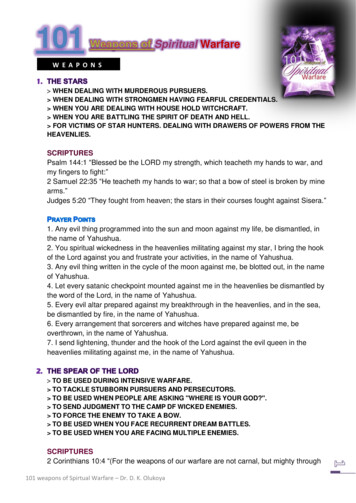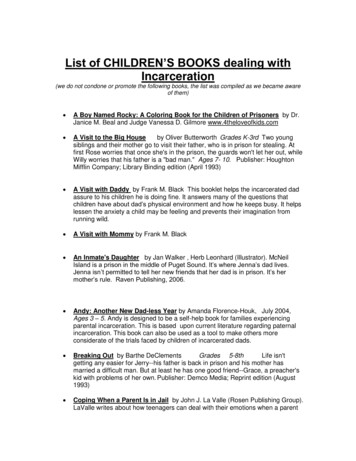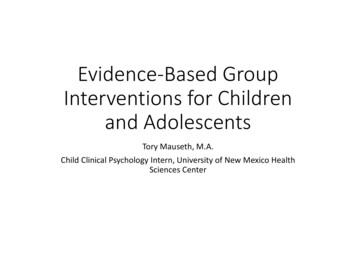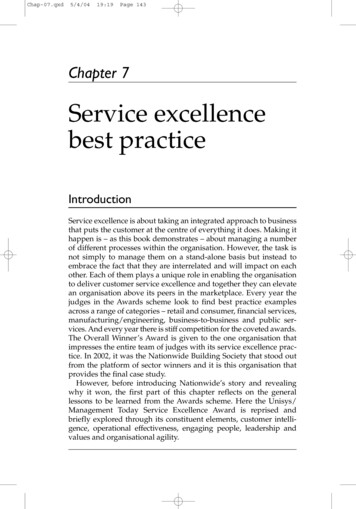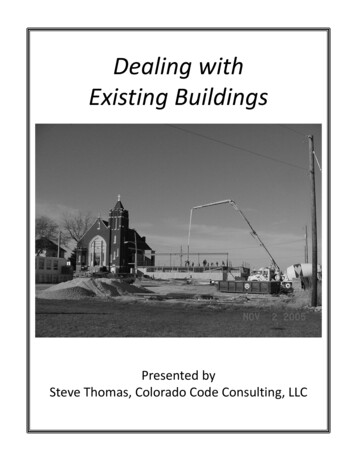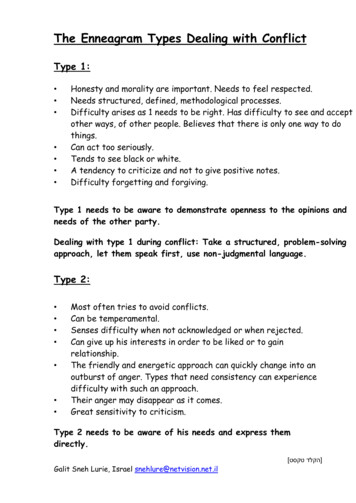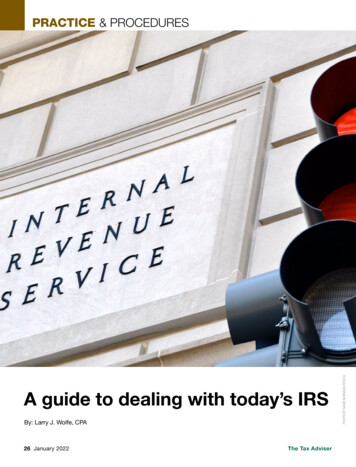
Transcription
A guide to dealing with today’s IRSBy: Larry J. Wolfe, CPA26 January 2022The Tax AdviserPHOTO BY MARCNORMAN/ISTOCKPRACTICE & PROCEDURES
This article provides practicalsuggestions to help practitionersnavigate the process of resolving issueswith the IRS. During the past twoyears, dealing with IRS Collection,Examination, and Appeals has beenespecially challenging. The information presented here about “workingthe system” through knowledge ofprocesses and procedures is subjectto change, and a practitioner shouldmonitor the IRS website to keepup to date on the latest resumptionsor disruptions of services and otherdevelopments.Due to the COVID-19 pandemicand reduced personnel, practitionersshould expect continued delays fromthe Service in live phone support, answering mail from taxpayers, reviewingpaper returns and (even) e-filed returns,and processing payments, among otherissues resulting from current challenging circumstances.Status of processingForms 1040 for 2020As of this writing, the IRS is opening correspondence within the normaltime frames, but processing is takinglonger than usual. Practitioners shouldbe patient and follow up with all correspondence within 60 days. Paper andelectronic individual Forms 1040, U.S.Individual Income Tax Return, receivedprior to April 2021 have been processedif the return had no errors and did notrequire further review. The IRS saysthat, as of Nov. 12, 2021, it had 5.9 million unprocessed individual returns. TheIRS suggests that taxpayers who havenot received refunds visit “Where’s MyRefund?” at irs.gov/refunds to checkthe status.Status of processing Form 941As of Nov. 17, 2021, the Service had2.4 million unprocessed Forms 941,Employer’s Quarterly Federal Tax Return.www.thetaxadviser.comIf a Form 941 was filed electronicallyand an acknowledgment was received,no further action is needed other thanresponding to notices and requests forinformation. The IRS advises taxpayersnot to file a second return. The inventoryof Forms 941 is being processed at theCincinnati and Ogden Service Centers.Status of processingForm 1139 or Form 1045Expect long delays. Mail the Form 1139,Corporation Application for TentativeRefund, or Form 1045, Application forTentative Refund, by certified mail andinclude a cover letter. A practical wayto confirm receipt is to include a checkpayable to the U.S. Treasury for 1.Apply the check to the tax and period ofthe amended return and attach a coverletter with the return and check.Sending checks to the IRSExpect delays in processing checks up to60 days or more. Fortunately, paymentsare applied on the date they are receivedand not when they are processed. TheIRS has been forgiving dishonoredcheck penalties if checks do not clearbecause of processing delays. This applies to payments received from March1, 2020, through Dec. 31, 2020, according to information on the IRS websiteas of this writing.For checks that were dishonoredin 2021, one can, as a practical matter,request penalty abatement due to processing delays. Attempt to substantiatethat the funds were available in the bankon the date that the check was mailed tothe IRS. The preparer will need to showreasonable cause to receive penalty relief.e-ServicesSign up for e-Services to be able toreceive transcripts through a securemailbox and be able to file a powerof attorney through the IRS’s newplatform, Tax Pro Account, availableat tinyurl.com/3xe8y644. E-Services isavailable 24/7. The phone number toResponding to theCP2000 timely byletter only (without aformal written protestor a Form 12203) willnot preserve the rightto appeal.reach the e-help desk for tax professionals is 866-255-0654, and hours ofoperations are 7:30 a.m. to 7 p.m. ET.Practitioner Priority ServiceThe Practitioner Priority Service (PPS)will assist practitioners with their clients’tax issues, including misapplied payments, math errors that need correction,account adjustments, balances due, andmissing returns. Under a recent change,PPS assistors can no longer take actions for collection activities, includingshort-term payment plans and installment agreements; these matters willrequire contacting the Small Business/Self-Employed (SB/SE) Division’sAutomated Collection Service (ACS).To reach PPS during the normal operating hours of 7 a.m. to 7 p.m. ET, call866-860-4259. (After hours, try callingthe Automated Collection Service at800-829-3903 or 800-829-8374.)PPS will route calls based on callers’ selections:Press 1: General tax law questions.Press 2: Questions about individualaccounts not in collection or examination status that involve issues concerning locating and applying payments,general procedural guidance and timeframes, making adjustments, providingtaxpayer transcripts, securing taxpayerincome verification, forgotten/lost CAFnumbers, and explaining IRS communications. Calls are limited to five clientsand 30 transcripts per client (increasedfrom 10 transcripts on Nov. 15, 2021).January 2022 27
PRACTICE & PROCEDURESPress 3: For questions on business accounts not in collection orexamination status that involve issuesconcerning locating payments, making adjustments, general proceduralguidance and time frames, providingtaxpayer transcripts, securing incomeverification, employee identificationnumber verification, forgotten/lostCAF numbers, and explaining IRScommunications. Calls are limited tofive clients and 30 transcripts per call(increased from 10 transcripts on Nov.15, 2021).Press 4: If a client’s account is inAutomated Collection System status.Press 5: For questions about anAutomated Underreporter Notice thata client received. There is normally aphone number on the top right-handcorner of the Notice’s front page.If the phone number is800-829-8310, press 1.If the phone number is800-829-3009, press 2.If the phone number is877-571-4712, press 3.Press 6: If a client’s account isunder Correspondence Examination,there is normally a phone number at thetop right-hand corner of the notice’sfront page.If the number is 866-897-0161,press 1 (SB/SE Examination).EXECUTIVE SUMMARY In today’s environment, a taxpractitioner must be patient anddocument all contact with the IRS. Although the IRS is opening correspondence within the normaltime frames, processing is takinglonger than usual. Practitioners can obtain assistance with their clients’ tax issues28 January 2022If the number is 866-897-0177, press2 (Wage and Investment Examination).Need to release a federaltax lienRequests for lien discharges, withdrawals, and subordinations are being assigned within 10 days, according to theIRS website as of this writing. Use thee-fax line for the Advisory ConsolidatedReceipt (ACR) site (844-201-8382) forthe request. IRS Publication 4235, Collection Advisory Offices Contact Information, lists the Advisory Group phone andfax numbers and mailing addresses andprovides more information on how tosubmit applications for lien certificatesand related topics.Reversing passportrevocationAfter a COVID-19-related pause inactivity, the IRS in July resumed notifying the State Department of taxpayerscertified as owing seriously delinquenttax debt, to enable the department totake actions such as denying the person’spassport application or revoking a current passport. Under these passportrules, seriously delinquent tax debtmeans owing the government more than 54,000 (adjusted yearly for inflation)in back taxes, penalties, and interest,for which:from a variety of sources in the IRSincluding the Practitioner PriorityService, a local stakeholderliaison, the Taxpayer AdvocateService, and others. Make sure to carefully read everynotice sent to a client. Becausenotices are changing, doublecheck due dates and appealrights that are being offered. Eventhough the IRS has said that nofurther action is needed once a A Notice of Federal Tax Lien hasbeen filed and all administrativeremedies under the law have lapsedor have been exhausted; or A levy has been issued.The IRS will send the taxpayer a notice CP508C notifying the taxpayer thathe or she has a seriously delinquent taxdebt that has been certified to the StateDepartment. The IRS will send thetaxpayer a notice CP508R at the timeit reverses a certification. The taxpayer’srepresentative will not receive a copy ofthe CP508C or CP508R even thoughthe power of attorney is on file.Internal Revenue Manual (IRM)Section 5.1.12.27, Passport Revocation,explains ways that a taxpayer may obtaina reversal of the revocation. A taxpayermay submit full payment of the liabilityor submit a processable offer in compromise (OIC). Pending installment agreements will also reverse the revocation, aswill having the taxpayer’s account placedin currently not collectible status.Responding to noticesRead all notices carefully. Becausenotices are changing, make sure todouble-check due dates and if thenotice is offering Collection AppealsProgram (CAP) rights (i.e., the rightto appeal the IRS’s filing of a levy or afederal tax lien).notice is answered, a practitionershould generally follow up with theIRS after 60 days if a response isnot received. For cases going to Appeals, practitioners should obtain a copy ofthe taxpayer’s administrative files,either through the case file accessprocedures or a FOIA request.The Tax Adviser
An example of a notice offering CAPrights is CP504. Within 30 days of thedate of the notice, the taxpayer shouldcall the IRS at the number listed in theCP504 and send a Form 9423, CollectionAppeal Request, by certified mail to theaddress that issued the notice.Mail the response to the correspondence to the address at the top left ofthe notice unless the notice specifiesdifferently. Identify in the response anyprocedural steps that were not followed,previous correspondence, and a proposedresolution. Responses to notices shouldinclude the following information: Taxpayer’s name and Social Securitynumber (SSN) or employer identification number; Period and type of tax; The notice number and the date ofthe notice; Action that the client is requesting,such as an installment agreement,abatement of penalty, no lien beingfiled, or no levy due to financialhardship; Identification of procedural issues notfollowed.CP522, CP523, and CP2000FormsIRM Section 21.3.1.5 discusses varioustypes of notices and the required actionsfor taxpayers that receive these notices.The CP522, CP523, and CP2000 arediscussed below.CP522: This notice states that aninstallment agreement will default in10 days unless the taxpayer calls theIRS within 10 days of the notice dateat the number listed in the notice toprovide updated financial information.Call the number on the notice. If thephone number is consistently busy, writea letter to the address on the notice,provide Form 433-F, Collection Information Statement, and/or a Form 433-A,Collection Information Statement for WageEarners and Self-Employed Individuals,and file Form 9423, requesting CAPrights regarding the default on thewww.thetaxadviser.cominstallment agreement. State on theForm 9423 that the taxpayer called thephone number on the notice and the callwent unanswered. State that the IRSdid not follow its own procedures, andrequest that the installment agreementnot be defaulted. The best practice is tosend the response by certified mail.CP523: This notice is used to informthe taxpayer that the IRS intends toterminate an installment agreement andto seize (levy) wages. There is a toll-freenumber listed at the top-right cornerof the page. The notice will state thereasons the installment agreement isgoing to default. A response is neededwithin 30 days of the date of the notice.File Form 9423, requesting CAP rightsto protect the taxpayer’s rights. Wherethere is not an agreement on procedural issues, request that the installmentagreement not be defaulted. Mail theresponse by certified mail. Usually, anew liability, a late filing of a return, ora missed payment will cause the default,but misapplied payments will also causethe CP523 to be issued. Practitionersshould work with the taxpayer to try tocure the default after the Form 9423is filed.CP2000: This notice is issued whenthe IRS receives income, deduction, orcredit information that does not matchthe taxpayer’s return. In the CP2000, theIRS proposes changes to the taxpayer’sreturn based on these discrepancies. Ifthe taxpayer does not agree with some orall of the changes proposed by the IRSon the CP2000, in order to preserve thetaxpayer’s right to appeal, the CP2000response form should be mailed to theIRS at the address indicated in the notice (or faxed to the number indicated inthe notice) within 30 days of the noticedate, accompanied by a signed statementand a formal written protest describingwhat the taxpayer disagrees with in theCP2000, including the accuracy-relatedpenalty. Filing the formal written protest will preserve the taxpayer’s appealrights and should prevent a 90-day letterIf collectibility isan issue, contactthe examiner and/or group managerto request thatthe scope of theexamination belimited.(Letter 3219) from being issued (thoughthis is not guaranteed). A formal writtenprotest should include: The taxpayer’s name, address, and adaytime telephone number; The taxpayer representative’s name,CAF number, address, and phonenumber, and attach Form 2848,Power of Attorney and Declaration ofRepresentative; List of all disputed issues, tax periodsor years involved, proposed changes,and reasons for disagreement witheach issue; Facts and law or authority supportingthe taxpayer’s position on eachdisputed issue; and A penalties of perjury statement (seeIRS Publication 5, Your Appeal Rightsand How to Prepare a Protest, If YouDisagree, for the correct wording forthe statement).If the taxpayer’s total amount oftax and penalties for each tax periodinvolved is 25,000 or less in the letterthe taxpayer received, the taxpayer maymake a small case request using Form12203, Request for Appeals Review, instead of filing a formal written protest.If the total amount of tax due for anyperiod involved is more than 25,000,Form 12203 cannot be used.Responding to the CP2000 timelyby letter only (without a formal written protest or a Form 12203) will notpreserve the right to appeal. If thetaxpayer agrees with the proposed taxJanuary 2022 29
PRACTICE & PROCEDURESThe localstakeholder liaisonis a good source forpractitioners to obtainphone numbers of IRSpersonnel.but an accuracy-related penalty is beingproposed, a response is still necessary toprevent the assessment of the accuracyrelated penalty. Both a formal writtenprotest or a Form 12203 and a letter areneeded to prevent the assessment of theaccuracy-related penalty, and reasonable cause must be shown. CP2000procedures are discussed in IRM Sections 4.19.2 and 4.19.3. Precomputation notice procedures are discussed inIRM Section 4.19.3.22.61. Extensionrequests are discussed in IRM Section4.19.3.22.7.3. Accuracy-related penaltyprocedures are discussed in IRM Section 4.19.3.22.1.4. Outgoing calls totaxpayers by Automated UnderreporterProgram (AUR) employees assignedthe case are discussed in IRM Section4.19.3.22.2.5.1. The IRM states thatthe AUR employees assigned the casemust call the taxpayer when an Appealsconference is being requested. Appealsprocedures are discussed in IRM Section4.19.3.22.1.8.Further instructions specific toincome issues can be found in IRMSection 4.19.3.22.3. Rescinding statutory notices is discussed in IRM Section4.19.3.22.11.2 and addresses taxpayerswho request an Appeals conference.Status of responses to lettersor notices (nonappealable)Expect delays. The IRS suggests thatonce a notice is answered, no furtheraction is needed. Even so, a practitionershould follow up on all responses tonotices after 60 days if a response is not30 January 2022received, in keeping with normal practices. For noncertified mail responses, oreven certified mail responses, an effectiveway to confirm that the IRS received aresponse to a notice is to have the clientwrite a check payable to the IRS for 1and apply the check to the tax year andtype of tax on the notice. State in theresponse: “Enclosed find check [number] in the amount of 1 to be appliedtoward the tax and year stated in thenotice.” The canceled check will be proofof the receipt of the response.SB/SE Examination:Face-to-face meetingsMost SB/SE field examinations as ofthis writing are being done virtually.Face-to-face interactions must be agreedto by the IRS employee and the taxpayer,and the request must be submittedthrough the IRS group manager to theterritorial manager for approval. Officeexaminations will continue to be virtualuntil further notice.Other examinations issuesFor collectibility, see IRM Sections4.10.2.4.1 and 4.10.7.4.6. If collectibilityis an issue, contact the examiner and/orgroup manager to request that the scopeof the examination be limited.For a survey of a return, see IRMSection 4.10.2.5.1, which discusses conditions allowing a return to be surveyedafter assignment and after the taxpayerhas been contacted by the examiner, butbefore records have been inspected. Thiscould include circumstances where thetaxpayer is deceased or has a terminal illness, has experienced a business closure,or has other circumstances that wouldjustify the survey of a return. If the decision is made to survey the return afterthe taxpayer has been contacted, a Letter1024, Return Accepted as Filed, is issued.To reschedule an initial appointment,see IRM Section 4.10.2.9.4, which statesthat the examiner should attempt to accommodate the taxpayer when a requestto reschedule the initial appointmentis reasonable. Subsequent requests andrequests to reschedule over 45 days mustbe approved by the group manager.SB/SE collection field workand face-to-face meetingsFor the most part, revenue officers havenot been conducting work in the field.As of this writing, face-to-face meetingsare only authorized when (1) there areno alternatives to face-to-face case contact, and the failure to act poses a risk ofpermanent loss to the government, suchas a statute expiration, pyramiding Form941 liabilities, or assets being placed outof reach of the government, or (2) thetaxpayer or representative has requestedface-to-face contact and the revenueofficer’s manager agrees to the face-toface contact.Installment agreements:Service Center onlyMost taxpayers who qualify for a shortterm installment agreement currentlyhave up to 180 days to resolve their taxliabilities instead of 120 days (see IRSNew Release IR-2020-248). In general,individuals qualify for this extra timeif they owe 50,000 or less and havefiled all required returns; businessesqualify if they owe 25,000 or less andhave filed all required returns. Certaintaxpayers who are assessed less than 250,000 may set up an installmentagreement without providing a financial statement or substantiation if themonthly payment proposal can pay offthe liability over the life of the collection statute.Some individual taxpayers who areassessed less than 250,000 for the 2019tax year may qualify to set up an installment agreement without the filing of aNotice of Federal Tax Lien and withoutproviding a financial statement. Qualified taxpayers with existing direct debitinstallment agreements may be able touse the Online Payment Agreementsystem to propose a lower monthly payment amount and change their paymentThe Tax Adviser
due date. Taxpayers who cannot paycan contact the IRS to request that theaccount go into currently not collectible status.The local stakeholder liaisonIn today’s environment, a practitionermust be patient and document allcontact with the IRS. The practitionershould obtain the name and ID numberof all IRS personnel that are contactedand attempt to obtain the name andnumber of the next level of manager.The local stakeholder liaison is a goodsource for practitioners to obtain phonenumbers of IRS personnel.A stakeholder liaison establishesrelationships with practitioners and industry organizations representing smallbusiness and self-employed taxpayers.The liaison provides information aboutpolicies, practices, and procedures theIRS uses to ensure compliance withthe tax laws, and elevates issues thataffect tax administration. To establish arelationship with a stakeholder liaison orreport an issue, refer to the “StakeholderLiaison Contacts” table below to find alocal contact. (Also see the table “OtherHelpful Contact Numbers” on p. 32.)The Taxpayer AdvocateServiceThe Taxpayer Advocate Service (TAS) isanother source of help for practitioners.Form 911, Request for Taxpayer AdvocateService Assistance, must be submitted toTAS. Case acceptance criteria take intoconsideration economic burden, systemicburden, the best interest of the taxpayer,and public policy.Visit the TAS’s website attaxpayeradvocate.irs.gov to obtain thefax number of the local taxpayer advocate office or read Publication 1546,Taxpayers Advocate Service. The toll-freenumber for the TAS is 877-777-4778.Freedom of Information ActguidelinesA Freedom of Information Act (FOIA)request must be in writing and canbe submitted by faxing the request to877-891-6035 or by mailing it to the Internal Revenue Service, GLDS SupportServices, Stop 93A, P.O. Box 621506,Atlanta, GA 30362. Letters requestingrecords under FOIA can be short andsimple. A requester who follows theIRS’s specific procedures may receive afaster response.A FOIA request letter must bewritten and signed by the requester.The following elements are required inthe letter: A statement that the request is beingmade under the Freedom of Information Act. Identification of the records thatare being sought as specifically aspossible. The name and address of therequester. Proof of identity and proof ofthe requester’s authority to accessthe information if the records areconfidential and not available to thegeneral public (e.g., records subject tothe Privacy Act or Sec. 6103). The requester’s category. The categories of requesters are: commercialuse, news media, educational ornoncommercial scientific institutions,and others (including individual).Stakeholder liaison contactsStakeholder liaison areaPhoneEmailArea 2 (CT, DE, MA, MD, ME, NH, NJ, PA, RI,VT, WV)412-404-9151CL.SL.Area.2@irs.govArea 3 (AR, AL, DC, IN, KY, LA, MI, MS, OH,OK, TN, VA)405-982-6807CL.SL.Area.3@irs.govArea 4 (FL, GA, NC, NY, SC, TX)216-415-3518CL.SL.Area.4@irs.govArea 5 (AZ, CA, HI, NM, NV)203-492-8630CL.SL.Area.5@irs.govArea 6 (AK, CO, IA, ID, IL, KS, MN, MO, MT,NE, ND, OR, SD, UT, WA, WI, WY)206-946-3703CL.SL.Area.6@irs.govSource: IRS.www.thetaxadviser.comJanuary 2022 31
PRACTICE & PROCEDURES An agreement to pay all processingfees for the requested records. Anoption exists to include an upperlimit on the amount the requesteris willing to pay to complete therequest.The complete regulatory requirements for FOIA requests filed with theIRS are available at Regs. Sec. 601.702.The FOIA request letter should startoff as follows:Dear Disclosure Officer:This is a request under the Freedom of Information Act, 5 U.S.C.552 and 26 U.S.C. Section 6103 andIRM Section 11.3.2.4.13.We request that a copy of thefollowing documents in referenceto [taxpayer] be sent to [practitionername and address] as representativeof [taxpayer and SSN].FOIA requests relating to trustfund penaltiesTrust fund penalty disputes are sometimes intertwined with penalty relief requests, OICs, innocent spouse cases, andother issues. A sample FOIA request inthis context might read in part:We request copies of all noticesand letters sent to [individual assessed and SSN] regarding theproposed assessment of the TrustFund Recovery Penalty for theForms 941 quarterly periods ending:12/31/2017, 6/30/2018, 9/30/2018and 12/31/2018.We request the names(s) of anyother person determined to be liable and whether the Service hasattempted to collect the penaltyfrom the other liable person(s) andthe general nature of the collectionactivities and the amount collected.We request the Internal RevenueService history sheets including butnot limited to, the Integrated Collection System (ICS) history sheetsin reference to the determination of32 January 2022Trust Fund liabilities for persons of[name of corporation and federal employer identification number (FEIN)and address and all the periodsinvolved], i.e., for the Form 941 periods ending: 12/31/2017, 6/30/2018,9/30/2018 and 12/31/2018.We request the names of the Internal Revenue Service Revenue Officers or any other Internal RevenueService employee’s case files, notes,workpapers, administrative file, history sheets including but not limitedto notes and records of third-partycontacts, third-party interviews,a list of third-party contacts, client interviews, handwritten notes,emails, records created or obtained,time sheets, including but not limited to printed or typed documents,tape recordings, maps, photographs,computer printouts, computer tapesor disks, or any similar items ofany IRS employee in reference tothe Trust Fund Investigation thatdetermined Trust Fund Liability forpersons of [name of entity, FEIN,address and periods involved], i.e.,for the Form 941 periods ending:12/31/2017, 6/30/2018, 9/30/2018and 12/31/2018.Be sure to attach powers of attorneyfor all entities and individual taxpayersinvolved in the request.Appeals conferences:Right to access case fileFor cases going to Appeals, practitionersshould generally request the administrative files or access to the nonprivilegedportions of the case file on record regarding the disputed issues (the administrative files) through the case file accessprocedures (see s-records).This is of vital importance. If the administrative files are of a type not availablethrough the case file access procedures, orthe taxpayer does not qualify to use theseprocedures, the practitioner should makea FOIA request for the files.Due to COVID-19, Appeals technical employees have been permittedOther helpful contact numbersSecured access registration888-841-4648General collection800-829-0922Automated Collection Service800-829-3903 or 800-829-7650;callback numbers are sometimes available.Practitioner Priority Service line866-860-4259Appeals Customer Service559-233-1267Affordable Care Act InformationReturns help desk866-937-4130The Tax Adviser
to send emails with SecureZip, whichcreates ZIP files that are encrypted, totransmit the redacted case file to taxpayers and their authorized representatives.Under the Taxpayer First Act, P.L.116-25, when a conference has beenscheduled, the Independent Appeals Office must ensure that a specified taxpayeris provided access to his or her administrative file, other than documents thetaxpayer has provided to the IRS, nolater than 10 days before the date ofthe conference. A specified taxpayer isdefined as any taxpayer whose adjustedgross income on the original filed returndoes not exceed 400,000 for the taxyear to which the dispute relates, or anynonindividual taxpayer (entity) whosegross receipts do not exceed 5,000,000for the year to which the dispute relates.If multiple tax periods are associatedwith a dispute, the IRS regards the taxpayer as eligible for access to the case fileif any one period meets the above criteria. As a best practice for practitioners, itis recommended that the request for thecase file be incorporated into the requestseeking Appeals’ review of the case.Since formal guidance is lacking, thefollowing sample wording is suggestedwhen requesting the administrative file:This is a request under the Freedomof Information Act, 5 U.S.C. Section 552, and IRC Sec. 6103, IRMSection 11.3.2.4.13, and the Taxpayer First Act.We request a copy of the following documents in reference to[taxpayer’s name] innocent spouserequest for the income tax years[xx,xx,xx,xx]. The documents shouldbe sent to [practitioner and addressand email address] as representativeof [taxpayer name]. All Internal Revenue Servicedocuments and history sheets ofany IRS employee in the InnocentSpouse Unit, including [name],and the senior manager, including[name], in the Innocent SpouseOperation Unit, involved in thepreliminary determination to denyinnocent spouse relief to [taxpayer] for the income tax liabilitiesfor tax years 2011 and 2012. All Internal Revenue Serviceemployees’ case files, notes, workpapers, administrative file, historysheets, including but not limitedto notes and records of third-partycontacts, third-party interviews, alist of third-party contacts, clientinterviews, handwritten notes,emails, records created or obtained, including but not limitedto printed or typed documents,computer printouts, computertapes or disks, or any similar itemsof any IRS employee in referenceto the denial of innocent spouserelief for [taxpayer name] forincome tax years 2011 and 2012.Diligent advocacyBe patient, document all work, and follow up within 60 days if no responseis received. Protect the clients’ rightsas taxpayers. Remember that not allIRS personnel are up to date on thenew changes and IRS procedures arenot always followed by IRS personnel.Speaking to a manager can be helpfulwhere a practitioner believes that properprocedures are not being followed. Everyone has a boss.Remember to reassure clients astheir advocate, but do not guaranteeresults in today’s environment. Keepclients informed throughout the processof working with the IRS, and most ofall be patient. ContributorLarry J. Wolfe, CPA, is the owner ofLarry J. Wolfe Ltd. in Skokie, Ill. He is aformer chair of the AICPA’s Tax Practiceand Procedures Committee. For moreinformation about this article, contactthetaxadviser@aicpa.org.AICPA RESOURCESArticlesReference chartKarl, “COVID’s Impact on Penalties and IRS Services,” AICPAInsights blog (Sept. 17, 2021), tinyurl.com/huxree96IRS Hotlines Quick Reference Chart, tinyurl.com/2jc724np(AICPA members)Stigile, “Resolving IRS Hardships With the Taxpayer AdvocateService,” 51 The Tax Adviser 666 (October 2020),tinyurl.com/msbvdp38CPE self-studyIRS Disputes: Identifying Options for Your Clie
reach the e-help desk for tax profes-sionals is 866-255-0654, and hours of operations are 7:30 a.m. to 7 p.m. ET. . Program (CAP) rights (i.e., the right to appeal the IRS's filing of a levy or a federal tax lien). EXECUTIVE SUMMARY In today's environment, a tax practitioner must be patient and document all contact with the IRS.
